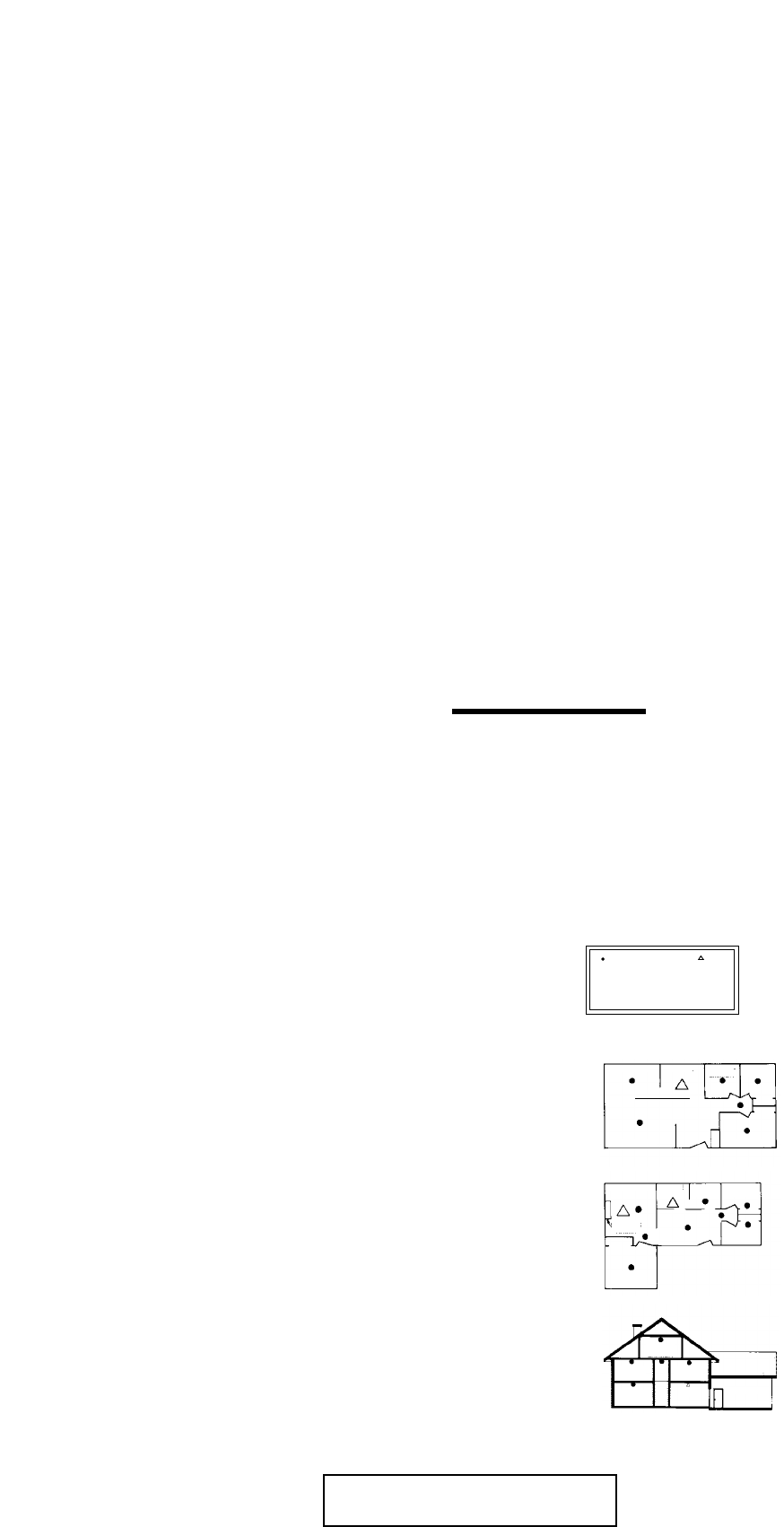
•
Install a smoke alarm in every room and on every level of the home.
Smoke may not reach the smoke alarm for many reasons. For example, if
a fire starts in a remote part of the home, on another level, in a chimney,
wall, roof, or on the other side of a closed door, smoke may not reach the
smoke alarm in time to alert household members. A smoke alarm will not
promptly detect a fire EXCEPT in the area or room in which it is installed.
•
Interconnected smoke alarms installed in every room and on every
level of the household offers maximum protection. We recommend inter-
connecting smoke alarms so that when one smoke alarm senses smoke
and sounds its alarm, all others will sound as well. Do not interconnect
smoke alarms from one individual family living unit to another. Do not con-
nect this smoke alarm to any other type of alarm or auxiliary device.
•
Smoke alarms may not alert every household member every time.
The alarm horn is loud in order to alert individuals of a potential danger.
However, there may be limiting circumstances where a household mem-
ber may not hear the alarm (i.e. outdoor or indoor noise, sound sleepers,
drug or alcohol usage, the hearing impaired, etc.). If you suspect that this
smoke alarm may not alert a household member, install and maintain
specialty smoke alarms. Household members must hear the alarm’s
warning sound and quickly respond to it to reduce the risk of damage,
injury, or death that may result from fire. If a household member is hear-
ing impaired, install special smoke alarms with lights or vibrating devices
to alert occupants.
•
Smoke alarms can only sound their alarms when they detect
smoke. Smoke alarms detect combustion particles in the air. They do
not sense heat, flame, or gas. This smoke alarm is designed to give
audible warning of a developing fire. However, many fires are fast-burn-
ing, explosive, or intentional. Others are caused by carelessness or safe-
ty hazards. Smoke may not reach the smoke alarm QUICKLY ENOUGH
to ensure safe escape.
•
Smoke alarms have limitations. This smoke alarm is not fool-proof
and is not warranted to protect lives or property from fire. Smoke alarms
are not a substitute for insurance. Homeowners and renters should
insure their lives and property. In addition, it is possible for the smoke
alarm to fail at any time. For this reason, you must test the smoke
alarm weekly and replace every 10 years.
SMOKE ALARM PLACEMENT
It is recommended to achieve complete coverage protection by installing
a smoke alarm in every room of your home.
At a minimum, smoke alarms shall be installed outside of each separate
sleeping area in the immediate vicinity of the bedrooms and on each addi-
tional storey of the family living unit including basements and excluding
crawl spaces and unfinished attics. Any home requires a minimum of two
smoke alarms.
FOR BEST PROTECTION, IT IS RECOMMENDED THAT YOU
INSTALL A SMOKE ALARM IN EVERY ROOM
In addition, it is recommended that all smoke alarms be interconnected.
Typical Efficiency
Home (Apartment)
•
Install a smoke alarm on the ceiling
or wall closest to the sleeping area.
Install a smoke alarm with False Alarm
Control in the kitchen/living area.
Typical Single Storey Home
•
Install a smoke alarm on the ceiling or wall
inside each bedroom and in the hallway
outside each separate sleeping area. If a
bedroom area hallway is more than 9 m
long, install a smoke alarm at each end.
Typical Two-Storey Home
•
Install a smoke alarm on the ceiling or wall
inside each bedroom and in the hallway
outside each separate sleeping area.
If a bedroom area hallway is more than 9 m
long, install a smoke alarm at each end.
•
Install a smoke alarm at the top
of a first-to-second floor stairwell.
2
SLEEPING
AREA
KITCHEN
LIVING
AREA
FAMILY ROOMKITCHEN BEDROOM
BEDROOM
BEDROOM
FIREPLACE
DINING
ROOM
BEDROOM
BEDROOM BEDROOM
KITCHEN
LIVING
ROOM
GARAGE
DINING ROOM KITCHEN
LIVING ROOM
BEDROOMBEDROOM
BEDROOM
Key
• Smoke Alarm
∆ Smoke Alarm with False Alarm Control










